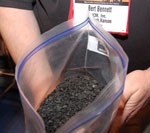The Intergovernmental Panel on Climate Change (IPCC) has released a paper on the potential of renewable energy and its impacts on reducing greenhouse gas emissions that are believed to contribute to global climate change. The report found that close to 80 percent of the world’s energy supply could be met by renewables by mid-century if supported by the right policies.
More than 120 researchers worked with IPPC on the report, “Special Report on Renewable Energy Sources and Climate Change Mitigation (SRREN),” and the findings also indicate that the rising penetration of renewable energies could lead to cumulative GHG savings of 220 to 560 gigatonnnes of carbon dioxide between 2010 and 2050.
 “With consistent climate and energy policy support, renewable energy sources can contribute substantially to human well-being by sustainably supplying energy and stabilizing the climate,” said Professor Ottmar Edenhofer, Co-Chair of Working Group III at the report launch. “However, the substantial increase of renewables is technically and politically very challenging.”
“With consistent climate and energy policy support, renewable energy sources can contribute substantially to human well-being by sustainably supplying energy and stabilizing the climate,” said Professor Ottmar Edenhofer, Co-Chair of Working Group III at the report launch. “However, the substantial increase of renewables is technically and politically very challenging.”
According to a news release, the upper end of the scenarios assessed, representing a cut of around a third in GHGs from business-as-usual projections, could assist in keeping concentrations of greenhouse gases at 450 parts per million. If this were the case, it could help to hold the increase in global average temperatures to 2 degrees Celsius, a goal laid out in the Cancun Agreements (COP-16).
Youba Sokona, Co-Chair of the Working Group III, said: “The potential role of renewable energy technologies in meeting the needs of the poor and in powering the sustainable growth of developing and developed economies can trigger sharply polarized views. This IPCC report has brought some much needed clarity to this debate in order to inform governments on the options and decisions that will needed if the world is to collectively realize a low carbon, far more resource efficient and equitable development path.”
The six renewable energy technologies reviewed were bioenergy, solar energy, geothermal energy, hydropower, ocean energy and wind energy. The report, which is a summary of a longer, 900 plus page research document, will feed into the broader work of the IPPC as they prepare its Fifth Assessment Report that is scheduled to be released in September 2014.
 Florida’s annual Farm to Fuel Summit has been postponed.
Florida’s annual Farm to Fuel Summit has been postponed. Florida Commissioner of Agriculture Adam Putnam sent out an announcement today saying that a bill passed during the recently concluded Florida legislative session prompted the decision.
Florida Commissioner of Agriculture Adam Putnam sent out an announcement today saying that a bill passed during the recently concluded Florida legislative session prompted the decision.

 At the International Biomass Conference and Expo last week, Dr. Janice Ryan-Bohac attracted a lot of attention carrying around a sweet potato the size of a newborn baby.
At the International Biomass Conference and Expo last week, Dr. Janice Ryan-Bohac attracted a lot of attention carrying around a sweet potato the size of a newborn baby.  According to the report, America’s ethanol producers supplied nearly 35 million metric tons (mmt) of livestock feed in the 2009/2010 marketing year, which is greater than the total amount of grain consumed by all of the beef cattle in the nation’s feedlots. For the current 2010/2011 marketing year, feed production from the ethanol industry is projected at 39 mmt.
According to the report, America’s ethanol producers supplied nearly 35 million metric tons (mmt) of livestock feed in the 2009/2010 marketing year, which is greater than the total amount of grain consumed by all of the beef cattle in the nation’s feedlots. For the current 2010/2011 marketing year, feed production from the ethanol industry is projected at 39 mmt.  The technology has the capacity to covert 150 tons of biomass per day to a syngas that can then be used a a fuel for industrial power and heating applications and Dr. Bert Bennett, ICM Principal Scientist and Process Engineer, says they have been working on it for over three years. “We actually put it in development in 2007. We built the unit and put it into action in 2009 and have been operating for over two years,” he said. “We’re really pleased with how the unit’s performed and now we’ve officially begun to commercialize it.”
The technology has the capacity to covert 150 tons of biomass per day to a syngas that can then be used a a fuel for industrial power and heating applications and Dr. Bert Bennett, ICM Principal Scientist and Process Engineer, says they have been working on it for over three years. “We actually put it in development in 2007. We built the unit and put it into action in 2009 and have been operating for over two years,” he said. “We’re really pleased with how the unit’s performed and now we’ve officially begun to commercialize it.” ICM tested more than 13 feedstocks and processed 7,000 tons of biomass over the past two years. “We put close to 4,000 tons of wood chips, that’s sort of the standard, a very easy fuel to do,” Bennett said. Other “hits” included refuse-derived fuels (RDF), tire chips, and corn stover. Some of the more challenging fuels they tested included manure, such as poultry litter.
ICM tested more than 13 feedstocks and processed 7,000 tons of biomass over the past two years. “We put close to 4,000 tons of wood chips, that’s sort of the standard, a very easy fuel to do,” Bennett said. Other “hits” included refuse-derived fuels (RDF), tire chips, and corn stover. Some of the more challenging fuels they tested included manure, such as poultry litter. 





